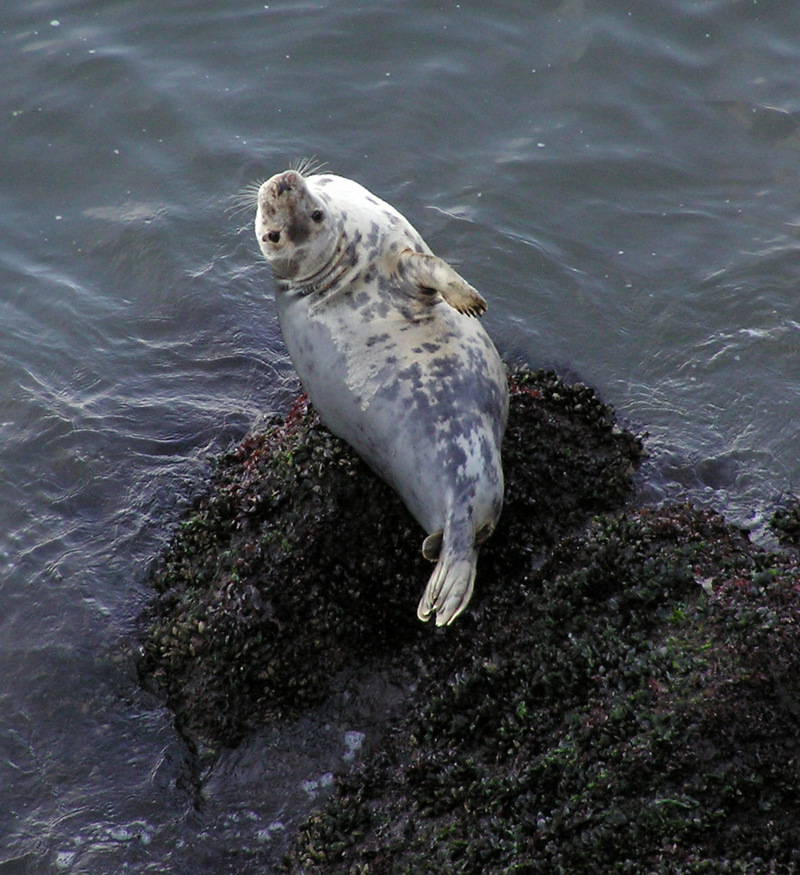|
| 질의: gulf herring | 결과: 7번째/8 | |
Grey Seal (Halichoerus grypus) - Wiki
| 제목: | Grey Seal (Halichoerus grypus) - Wiki
| |

| 해상도: 1186x1297
파일크기: 449668 Bytes
촬영일: 0000:00:00 00:00:00
사진기: C750UZ (OLYMPUS CORPORATION)
F number: f/3.7
Exposure: 10/2000 sec
Focal Length: 630/10
등록시간: 2007:12:21 15:09:21
|
Grey Seal
From Wikipedia, the free encyclopedia
Order: Carnivora
Family: Phocidae
[Photo] Grey Seal (Halichoerus grypus) at Rhossili on the Gower Peninsula, South Wales. Date September 2006. Author Yummifruitbat (http://commons.wikimedia.org/wiki/User:Yummifruitbat)
The Grey Seal (Halichoerus grypus) is found on both shores of the North Atlantic Ocean. It is a large seal of the family Phocidae or "true seals". It is the only species classified in the genus Halichoerus. Its name is alternatively spelled Gray Seal and it is also known as Atlantic Grey Seal.
Appearance
It is a medium sized seal, with the bulls reaching 2.5???3.3 m long and weighing up to 300 kg; the cows are much smaller, typically 1.6???2.0 m long and 100???150 kg weight. It is the typical seal of the northern and western coasts, the Common Seal being more often seen off southeastern coasts.
Ecology
In Britain and Ireland, the Grey Seal breeds in several colonies on and around the coasts; notably large colonies are at the Farne Islands off the Northumberland Coast (about 6,000 animals), and North Rona off the north coast of Scotland and Lambay Island off the coast of Dublin.
In the Western North Atlantic, Grey Seals are typically found in large numbers all along the coast of North America up to about the coastal waters of New Jersey in the United States. In Canada, they are typically seen in areas like the Gulf of St. Lawrence, Newfoundland and the Maritimes, and Quebec. In the United States one finds them year round off the New England coasts (in particular Maine and Massachusetts) and slightly less frequently in the Middle Atlantic States, though their natural range extends to Virginia. During the winter months they can be seen hauled out on the rocks, islands, and shoals not far from shore, like great grey bananas in the sun, and occasionally coming ashore to rest. In the spring the recently weaned pups and yearlings occasionally strand on beaches after becoming "lost".
Diet
Grey seals feed on a wide variety of fish, mostly benthic or demersal species, taken at depths down to 70m (230ft) or more. Sandeels (Ammodytes spp) are important in their diet in many localities. Cod and other gadids, flatfish, herring and skates are also important locally. However, it is clear that Grey seals will eat whatever is available, including octopus and lobsters. The average daily food requirement is estimated to be 5kg (11lb), though the seals do not feed every day and they fast the breeding season.
Reproduction
The pups are born in autumn (September to November) in the eastern Atlantic and in winter (January to February) in the west, with a dense, soft silky white fur; at first they are small and shrivelled-looking, but they rapidly fatten up to look like over-filled barrels, from the extremely fat-rich milk they receive from their mothers. Within a month or so, they shed the pup fur and grow the dense waterproof adult fur, and soon leave for the sea to learn to fish for themselves. In recent years, the number of grey seals has been on the rise in the west, and in Canada there have been calls for a seal cull, however this does not appear to be coming to fruition any time soon.
Status
In the United States grey seal numbers are increasing as well; they have been protected under the Marine Mammal Protection Act for several years and it is still illegal to harm one. Before the act there were only a few isolated colonies in Maine and nowhere else. Today they are seen increasingly near New York and New Jersey waters and it is very likely they will establish colonies further and further south provided the main Canadian pupping grounds are not molested. It is also not very likely a seal hunt shall be instituted any time soon in the U.S.
In the UK seals are protected under the Conservation of Seals Act 1970, however it does not apply to Northern Ireland. In the UK there have also been calls for a cull from some fishermen, claiming that stocks have declined due to the seals. A recent paper, however, from the Sea Mammal Research Unit at St Andrews University (www.smru.st-and.ac.uk/) clarifies that seals take less than 1% of the total stock biomass in the North Sea. The real problem is over fishing.
More images
http://commons.wikimedia.org/wiki/Halichoerus_grypus
http://en.wikipedia.org/wiki/Grey_Seal
| The text in this page is based on the copyrighted Wikipedia article shown in above URL. It is used under the GNU Free Documentation License. You may redistribute it, verbatim or modified, providing that you comply with the terms of the GFDL. |
|
^o^
동물그림창고 똑똑전화 누리집
^o^
|
|

